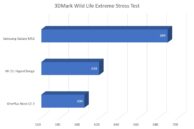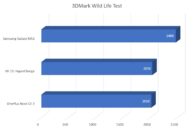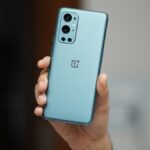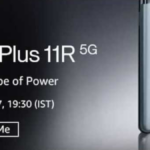
OnePlus is gradually expanding its Nord lineup in Indian and international markets to keep the strong sales momentum going. The OnePlus Nord CE 2 5G is the Chinese smartphone maker’s latest budget-centric offering. It is touted as the successor to the original OnePlus Nord CE, but little has changed on the hardware front. The new phone strikes a chord with its attractive pricing, but corners have been cut to get there, and they are immediately apparent. Read on to find out if the new OnePlus Nord CE 2 is worth buying.
The new OnePlus Nord CE 2 comes in two variants. The affordable one is priced at Rs. 23,999 ($313). It pairs the MediaTek Dimensity 900 processor with 6GB of LPDDR4X RAM and 128GB of UFS2.2 storage. We have the top-of-the-line variant for review, equipped with 8GB of RAM. It will set you back by an additional Rs. 1,000 ($13), bringing the sticker price up to Rs. 24,999 ($327).
The aggressive pricing puts the OnePlus Nord CE 2 in direct competition with the Xiaomi 11i and Samsung Galaxy M52 5G. Moreover, OnePlus hasn’t changed much with the new phone. Compared to its predecessor, the only noteworthy improvements come in the form of 65W SuperVOOC fast charging and a dedicated MicroSD card slot.
Is that enough of an upgrade for the OnePlus Nord CE 2 to hold its own in its fiercely competitive price segment? Let’s find out!
Design and Build Quality: Quintessential OnePlus
Once you peel back the plastic wrap and unbox your new Nord CE 2, you’ll find that it comes with a 65W charging brick and OnePlus’ signature red cable, a sheet of stickers, standard documentation, a Red Cable Club membership card, and a SIM ejector tool. A soft clear silicone case is also included with flaps to protect the USB-C port and headphone jack on the lower bezel.

The phone has a plastic frame and a glossy plastic back that loves to attract fingerprints. Unlike the Nord 2, the camera bump isn’t defined by sharp edges, and it doesn’t come with a contrasting matte finish either. The back panel slopes up to the protrusion and shares the same glossy plastic finish. Speaking of the camera bump, it is located on the upper left-hand side and protrudes by 2mm. That might not seem like much, but the phone rocks from side to side on flat surfaces, even with the protective case slapped on.
Our review unit was finished in the Bahama Blue color variant that resembles a baby blue hue. The glossy plastic side rails have a teal-ish green shade that doesn’t match the back panel. You can also get the phone in the Gray Mirror colorway if you prefer something subtle. The OnePlus Nord CE 2 weighs 173g, which is at the heavier end of the spectrum. Thanks to the dual-cell battery’s better weight distribution, the in-hand feel is relatively balanced.
The volume buttons are on the left edge, while the power button is placed on the right-hand side edge. The buttons are easy to reach and offer an excellent tactile response. Former and current OnePlus users will immediately notice that the Nord CE 2 misses out on OnePlus’ Alert Slider that lets you effortlessly toggle between ring, vibrate, and silent modes. The in-display fingerprint reader was fast and effective in unlocking the phone, though. So, heading to the notification shade to cycle through the ringer modes wasn’t too much of a hassle.


There is no Alert Slider above the power button on the OnePlus Nord CE 2
One of the most significant design changes with the OnePlus Nord CE 2 is the addition of a dedicated MicroSD card slot. It lets you expand the storage up to 1TB. If you plan to install several games, we suggest you factor in the cost of an SD card while purchasing this device. The spec sheet doesn’t say the phone is certified for sweat or water resistance, but in true OnePlus fashion, there’s a green rubber ingress protection seal around the SIM tray. The Nord CE 2 will probably withstand the odd splash and survive the odd rainy day, but we wouldn’t push our luck submerging the phone underwater.
The OnePlus Nord CE 2 comes with a 3.5mm headphone jack. You’ll probably prefer carrying your headphones around because the phone has just one downward-firing speaker that gets blocked by your finger easily, especially while gaming. Most other phones in this price bracket offer a stereo speaker setup, with Dolby Atmos being the cherry on top in some instances. We found that the location of the headphone jack made the phone particularly uncomfortable to hold in landscape mode. Headphones with angled connectors are therefore recommended.
Another mild disappointment was the vibration motor responsible for haptic feedback. It delivered jarring vibrations and didn’t feel crisp. It serves its intended purpose, but we have seen better in this price range.

Display and Connectivity: Bang for the Buck
Staying true to its CE branding that stands for Core Essentials, the OnePlus Nord CE 2 comes with a decently large 6.43-inch Fluid AMOLED display. Like several other budget and mid-range smartphones, this display offers a 90Hz refresh rate and a 2400×1080 pixel resolution. The high 409dpi pixel density means you won’t be spotting individual pixels unless you take a magnifying lens to it.
Moreover, the AMOLED panel doesn’t disappoint either. It offers the deep blacks and sharp contrast that the technology is known for. The panel supports the sRGB and DCI-P3 color space, with the latter enabled by default. You won’t need a screen protector as long as your phone doesn’t share the pocket with keys, coins, and knives since OnePlus has used Corning Gorilla Glass 5.
Under direct sunlight, we found that the readability wasn’t the best, even after cranking the brightness to the maximum. However, the 90Hz screen wasn’t a letdown, given how affordable the phone is. We had to dive into the settings and enable the 90Hz refresh rate, but once that was done, the OnePlus Nord CE 2 delivered a smooth experience while gaming and scrolling menus.
OnePlus Nord CE 2 shines on the connectivity front. The phone comes with a USB-C port on the bottom that supports USB 2.0 speeds on the included charging cable. Data transfer speeds from the phone to the PC were decently fast. It supports 5G and 4G cellular networks, although the latter is more prevalent in India. We didn’t experience any dropped calls or low cellular reception issues in our testing that spanned several weeks of daily use.
Voice calling over cellular networks worked perfectly, and the person we were speaking to could hear us clearly even when we called from noisy places. The OnePlus Nord CE 2 also supports dual-band Wi-Fi 6 and Bluetooth v5.2. The phone also allows you to use a wide range of audio codecs, including Qualcomm’s aptX, aptX HD, LDAC, AAC, and SBC. We had no issues using Bluetooth speakers and true-wireless earphones.
The OnePlus Nord CE 2 is right up there with the flagship smartphones in terms of connectivity. It even offers NFC, a feature several budget phones skimp on.


Visibility in direct sunlight isn’t the best, even with the display brightness maxed out
Battery Life and Software Experience: A Welcome Bonus
The OnePlus Nord CE 2 disappoints a bit on the software front. It comes with Android 11 from the factory, although Android 12 has been available for months now, and Android 13 developer preview builds have started rolling out. On the flip side, OnePlus retains a clean user interface with OxygenOS 11, so you aren’t greeted with annoying advertisements in the system apps, unlike Xiaomi’s MIUI.
OnePlus even lets you choose a system font during the initial setup instead of forcing OnePlus Sans like previous Nord phones. The OnePlus Sans font is clean but received mixed reviews when it was introduced. So, it is nice to see the company give its users choices here.
That doesn’t mean the user interface is flawless. By default, the swipe-down gesture on the home screen is set to open the OnePlus shelf, where the company tries to sell its Red Cable Club membership and additional services. We had to head into the launcher settings and change the swipe-down gesture to open the notification shade.
The OnePlus Nord CE 2 comes with 65W SuperVOOC fast charging — a significant step up from its predecessor. The charger bundled with the phone recharges the 4,500mAh battery in under 45 minutes. However, you cannot use an adjacent wall outlet for that duration because of how wide the charging brick is. To OnePlus’ credit, this new budget phone offers features we have seen on pricier OnePlus devices, such as Optimized Night Charging, so you can leave your phone plugged in overnight without any worries.
On a full charge, the OnePlus Nord CE 2 offered just over four days of standby time with GPS, Wi-Fi, and cellular turned on. We clocked an impressive 8 hours 25 minutes of continuous screen-on time, and the phone lasted one full day on a single charge with regular use. Note that mileage may vary. In a nutshell, battery performance is the Nord CE 2’s forte, thanks to fast charging and impressive screen-on time.

Performance: Decent for the Price
The OnePlus Nord CE 2 is equipped with the MediaTek Dimensity 900. The performance is nothing to write home about, but the phone is no slouch when pushed to the limit. The octa-core CPU is based on TSMC’s efficient 6nm process node. It comprises two ARM Cortex-A78 “performance” cores capped at 2.4GHz and six ARM Cortex-A55 “efficiency” cores capped at 2GHz clock speeds. Graphics duties are handled by the integrated ARM Mali-G68 MC4 GPU.
The chip supports faster LPDDR5 RAM, 120Hz displays, and UFS 3.1 storage but OnePlus stuck to using LPDDR4X RAM, a 90Hz display, and UFS 2.2 storage, seemingly in an attempt to keep costs down. These cost-cutting measures do take their toll on the OnePlus Nord CE 2’s performance in synthetic benchmarks and intensive real-world use cases.
We played Call Of Duty: Mobile on the device at high display settings, and except for the occasional stutter, the phone handled the intensive load like a champ. Gamers will probably get their money’s worth with the Nord CE 2.

We rely on acclaimed benchmarking tools to ensure repeatability and standardization in our testing. We pitted the OnePlus Nord CE 2 against the Xiaomi 11i and Samsung Galaxy M52. The phones are on a level playing field regarding pricing and RAM.
The key differentiator is that Samsung’s contender is powered by a Qualcomm Snapdragon 778G processor, while Xiaomi’s relies on a MediaTek Dimensity 920 SoC. On the 20-minute long 3DMark Wild Life Extreme Stress Test designed to evaluate performance and thermal management under sustained heavy load, the OnePlus Nord CE 2 scored the lowest and lost to Samsung by a considerable margin. On the Wild Life test that simulates a short burst of intense activity, the OnePlus Nord CE 2 was neck-and-neck with the Xiaomi 11i but lost to the Samsung yet again.
The PCMark Work 3.0 performance test evaluates how a smartphone performs while handling conventional everyday tasks like web browsing, image editing, and video editing. Here, the new OnePlus phone blows the Xiaomi 11i out of the water and loses to the Galaxy M52 by a hairsbreadth. On the PCMark Storage 2.0 benchmark that evaluates how fast the onboard storage is, the OnePlus Nord CE 2 beat the Samsung but lost to the Xiaomi 11i by a small margin.
While benchmark scores leave something to be desired, OnePlus deserves credit for the thermal management on the Nord CE 2. The phone didn’t get noticeably warm to the touch during charging or prolonged gaming sessions. This means the CPU won’t throttle performance to keep itself cool, and you will be able to wring out every drop of performance most of the time. Xiaomi’s 11i and the Samsung Galaxy M52 ran significantly hotter during the tests.
Camera Performance: Lacklustre at Best
Oneplus has equipped the Nord CE 2 with a triple camera setup on the rear. The primary camera has a 64MP sensor with an f/1.79 aperture and Electronic Image Stabilization (EIS). The ultrawide camera is an 8MP unit with an f/2.2 aperture and a 119-degree field of view. It gets EIS as well. The third lens is a 2MP macro shooter with an f/2.4 aperture.
In broad daylight, the primary camera excels in the 64MP mode and the default mode that outputs 16MP images, thanks to pixel binning technology. We found that the camera doesn’t represent colors accurately, and the image processing algorithm uses a cooler color temperature for all the photos. Lest we forget, the dynamic range wasn’t impressive either, and the skies were overexposed even with HDR turned on.
On the bright side, the images were crisp and detailed. At night, the primary camera suffers in the 64MP mode, with heavy vignetting around images and jagged color transition edges because of the smaller sensor. This issue can be fixed using the standard 16MP output, and it isn’t unique to the OnePlus Nord CE 2. We suggest using the 64MP mode only in daylight.
The OnePlus Nord CE 2’s ultrawide lens isn’t the best we have seen. It captures adequate detail and represents colors accurately. However, there are telltale signs of cost-cutting, including heavy distortion towards the edges of the image. This is typically caused by the use of cheaper materials to construct lenses. Low-light conditions further hamstring the performance. The lens fails to capture details at night, even when Night mode is enabled.

OnePlus’ Nord CE 2 does well in the video department as well, provided you’re in a well-lit area. It is capable of up to 4K recording at 30fps. The primary and ultrawide lenses have EIS that helps output steady handheld footage, so that’s a plus. OnePlus’ camera app is also user-friendly, although some photographic styles, modes, and effects are buried deep in the menus. However, in low light, the camera tends to hunt for focus and produces grainy footage.
We believe the few people who would use the 2MP macro lens would be rather unimpressed by its performance. This lens is essentially a gimmick that isn’t usable even in ideal lighting. We believe OnePlus should have used a better ultrawide lens instead of providing a 2MP macro shooter just to advertise a triple-camera array on a budget.
The front-facing 16MP camera uses a Sony IMX471 sensor paired with an f/2.4 lens. It also gets EIS, so your selfies aren’t blurred by the odd shake. The phone does a decent job with selfies, and edge detection on portrait mode works well. Tricky regions like spectacle frames and curly hair were also crystal clear.
Long story short, the Nord CE 2’s camera performance is its proverbial Achille’s heel. Rivals such as the Xiaomi 11i and Samsung Galaxy M52 outdo the Nord CE 2 on the spec sheet as well as in terms of real-world performance. You shouldn’t pick up this phone if camera performance ranks high up on your list of priorities. Check out some of the camera samples below:
- Shot using the primary lens in broad daylight
- Shot using the ultrawide lens in broad daylight
- Shot on the Nord CE 2’s primary camera using Night Mode
- Shot on the Nord CE 2’s ultrawide camera using Night Mode
- Shot on the Nord CE 2’s ultrawide camera
- Shot on the Nord CE 2’s primary camera
- Shot using the macro lens in bright indoor lighting
- A picture shot using the macro lens
Final Verdict
After using the new Nord CE 2 as a daily driver for a few weeks, we believe the phone offers excellent battery life, ad-free software experience, and an attractive design for the price. As the benchmarks revealed, performance isn’t exemplary for the price, but it is adequate. There isn’t a huge price difference between the 6GB and the 8GB models. So, unless you’re on a shoestring budget, you should just purchase the latter.

OnePlus enthusiasts could also opine the phone is let down by the recent software experience degradation. The camera performance and value for money quotient aren’t in OnePlus’ favor either. So, if you need an affordable barebones daily driver, you can consider the new Nord CE 2. However, stretching the budget slightly and looking past some flaws can get you the significantly better Xiaomi 11i and Samsung Galaxy M52 5G.
Are you interested in purchasing the OnePlus Nord CE 2? Was this review helpful for you? Please share your thoughts with us in the comments section below.






























